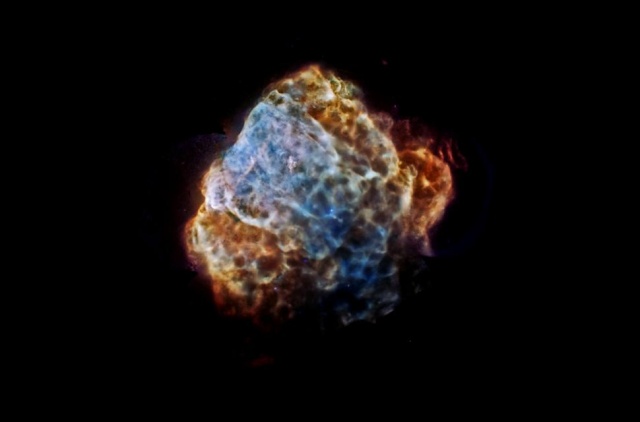Iceland from space
 |
| Iceland from space |
X-Ray Imaging of Supernova Remains
 |
| X-Ray Imaging of Supernova Remains |
SUN FLARE
From the view on our tiny, pale-blue dot called Earth, the sun is a bright, warm light. It’s what gives the plants and animals of this planet life, and illuminates our world. The reality, however, is that the Sun is a violent, tumultuous sphere of explosive chemical and nuclear reactions – that’s where all that life-giving heat and light come from. The Sun often emits solar flares – massive bursts of energy that disperse protons into space, and have been known to affect satellites and pose major risk to astronauts. This particular solar flare was captured by NASA’s Solar Dynamics Observatory on December 16, 2014. It’s ironic that something so violent and dangerous can be so beautiful.
BIRTH OF A STAR
The universe is brimming with countless stars, and they all start life as brightly shining Young Stellar Objects (YSO). This photo, taken by everyone’s favorite NASA/ESA space telescope, Hubble, on March 2, 2015, shows the early stages of life for the star V1331 Cyg. The star is still classified YSO, but will soon be approaching its main cycle – the same stage of life as our Sun.
GALACTIC VARIETY
Galaxies are curious things: They contain billions – often trillions – of stars, massive clouds of gas, and innumerable planets, all of them potentially light years apart. But taken in from a vast distance, they become glimmering clusters of multicolored starlight. This photo, again taken by Hubble, shows the beauty of NGC 7715 (and the arm of its companion NGC 7714). The light captured in this photo is over 100 million years old.
THE PILLARS OF CREATION
The Pillars of Creation – a massive nebula of stars, gas, and other materials being radio-actively super heated by the cluster of young stars — is one of the most iconic celestial bodies. An early photo of the nebula showed the enormous, gaseous pillars enshrouding the star cluster. But in early 2015, Hubble snapped this photo using a powerful camera that was able to penetrate the veil radioactive mist and capture the light of the stars behind it.
A MASSIVE BLACK HOLE IN A TINY GALAXY
At the heart of a densely star-packed dwarf galaxy, M60-UCD1, floats this super massive black hole holding it all together. NASA discovered the peculiar galaxy with the help of Hubble, which took the above photo on September 10, 2014. The discovery of this galaxy has lead NASA scientists to believe that there are likely many, many other dwarf galaxies with super massive black holes at their centers.
ANDROMEDA PANORAMA
Andromeda is the nearest galactic neighbor to the Milky Way, Earth’s galaxy. While none of us will ever be able to be physically present in Andromeda (and likely will never occur unless near-light speed travel and/or wormholes are ever discovered), we can still take in the view of the galaxy’s trillion stars – or, at least, the light of said stars from 2.54 million years ago. Hubble telescope captured the impressive photo on January 9, 2015.
SOLAR ECLIPSE
Solar eclipses used to be feared by ancient cultures who didn’t understand what they were or why they occurred; today they’re exciting solar events that bring people flocking to witness them. This photo snapped by ESA’s Proba-2 satellite captured the moment at which the moon covered the sun during a recent solar eclipse over Europe on March 20, 2015.
THE MOON
Much like the sun, the view of the moon from our terrestrial vantage point can sometimes leave something to be desired, especially once you’ve seen photos like this one, taken at the apex of a full moon during the lunar cycle by NASA’s Lunar Reconnaissance Orbiter on December 9, 2014. The high-definition photo gives a detailed look at the stark gray, crater-ridden surface or Earth’s moon.
Jupiter’s storm
The largest object in our solar system, Jupiter is a behemoth of a planet. Over 1,321 Earths could fit into Jupiter, and the planet is orbited by 16 moons (that we know of). But perhaps the most iconic feature of the gas giant is its massive storm, seen as a red dot circulating across its surface. This image gives us a glimpse of the vibrant and beautiful swirling gas clouds of Jupiter’s storm.
STORMS OVER INDONESIA
It’s easy to forget that Earth itself is capable of inspiring feelings of wonder when looking at photos of massive cosmic objects from distant corners of the universe, but the third rock from the sun is varied, complex, and beautiful. This photo, taken by an astronaut on the International Space Station on August 5, 2014, shows massive thunderheads above Borneo, Indonesia.
 |
| Add captionEd White walking in space |
 |
| Add captionSpace Shuttle Challenger disaster |
 |
| Add captionApollo 11 ‘Visor Image’Buzz Aldrin, the second man to set foot on the moon, poses while Neil Armstrong uses Buzz’s visor as a mirror in order to take a picture of himself. |
 |
| Add captionA stunning image of the star cluster Westerlund 2 and gas cloud Gum 29 was chose as the official photo for the Hubble telescope's 25th birthday. |
 |
| Add captionCleveland Volcano in Alaska |
 |
| Add captionAmongst their many projects at the time, NASA Ames proposed massive spaceships that would orbit communities of 10,000 people around the earth—planned . |
FRIENDS!!!Few things instill a sense of wonder quite like the views from space do. Whether the cameras are turned toward the stars, or back at Earth, there’s something about space photography that makes one feel at once very small, yet connected to something truly powerful. NASA photos show the beauty of Earth, our solar system, and far corners of the universe.
https://www.google.com.sa/
http://www.space.com
http://www.digitaltrends.com/photography/best-photos-of-space/



















No comments:
Post a Comment